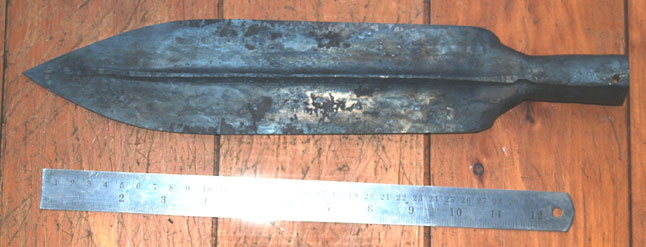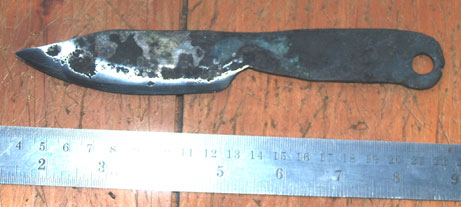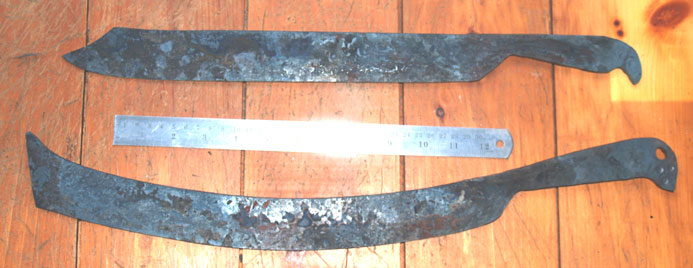Whether anything can properly be said in favour of the German Mensur I am doubtful; but if so it concerns only the two combatants. Upon the spectators it can and does, I am convinced, exercise nothing but evil. I know myself sufficiently well to be sure I am not of an unusually bloodthirsty disposition. The effect it had upon me can only be the usual effect. At first, before the actual work commenced, my sensation was curiosity mingled with anxiety as to how the sight would trouble me, though some slight acquaintance with dissecting-rooms and operating tables left me less doubt on that point than I might otherwise have felt. As the blood began to flow, and nerves and muscles to be laid bare, I experienced a mingling of disgust and pity. But with the second duel, I must confess, my finer feelings began to disappear; and by the time the third was well upon its way, and the room heavy with the curious hot odour of blood, I began, as the American expression is, to see things red.
I wanted more. I looked from face to face surrounding me, and in most of them I found reflected undoubtedly my own sensations. If it be a good thing to excite this blood thirst in the modern man, then the Mensur is a useful institution. But is it a good thing? We prate about our civilisation and humanity, but those of us who do not carry hypocrisy to the length of self-deception know that underneath our starched shirts there lurks the savage, with all his savage instincts untouched. Occasionally he may be wanted, but we never need fear his dying out. On the other hand, it seems unwise to over-nourish him.
In favour of the duel, seriously considered, there are many points to be urged. But the Mensur serves no good purpose whatever. It is childishness, and the fact of its being a cruel and brutal game makes it none the less childish. Wounds have no intrinsic value of their own; it is the cause that dignifies them, not their size. William Tell is rightly one of the heroes of the world; but what should we think of the members of a club of fathers, formed with the object of meeting twice a week to shoot apples from their sons’ heads with cross-bows? These young German gentlemen could obtain all the results of which they are so proud by teasing a wild cat! To join a society for the mere purpose of getting yourself hacked about reduces a man to the intellectual level of a dancing Dervish. Travellers tell us of savages in Central Africa who express their feelings on festive occasions by jumping about and slashing themselves. But there is no need for Europe to imitate them. The Mensur is, in fact, the reductio ad absurdum of the duel; and if the Germans themselves cannot see that it is funny, one can only regret their lack of humour.
Jerome K. Jerome, Three Men on the Bummel, 1914.
October 4, 2015
QotD: The “value” of the Mensur
September 27, 2015
QotD: Duelling at German universities
The Mensur has been described so often and so thoroughly that I do not intend to bore my readers with any detailed account of it. I merely come forward as an impressionist, and I write purposely the impression of my first Mensur, because I believe that first impressions are more true and useful than opinions blunted by intercourse, or shaped by influence.
[…]
Use blinds one to everything one does not wish to see. Every third German gentleman you meet in the street still bears, and will bear to his grave, marks of the twenty to a hundred duels he has fought in his student days. The German children play at the Mensur in the nursery, rehearse it in the gymnasium. The Germans have come to persuade themselves there is no brutality in it — nothing offensive, nothing degrading. Their argument is that it schools the German youth to coolness and courage. If this could be proved, the argument, particularly in a country where every man is a soldier, would be sufficiently one-sided. But is the virtue of the prize-fighter the virtue of the soldier? One doubts it. Nerve and dash are surely of more service in the field than a temperament of unreasoning indifference as to what is happening to one. As a matter of fact, the German student would have to be possessed of much more courage not to fight. He fights not to please himself, but to satisfy a public opinion that is two hundred years behind the times.
All the Mensur does is to brutalise him. There may be skill displayed — I am told there is, — but it is not apparent. The mere fighting is like nothing so much as a broadsword combat at a Richardson’s show; the display as a whole a successful attempt to combine the ludicrous with the unpleasant. In aristocratic Bonn, where style is considered, and in Heidelberg, where visitors from other nations are more common, the affair is perhaps more formal. I am told that there the contests take place in handsome rooms; that grey-haired doctors wait upon the wounded, and liveried servants upon the hungry, and that the affair is conducted throughout with a certain amount of picturesque ceremony. In the more essentially German Universities, where strangers are rare and not much encouraged, the simple essentials are the only things kept in view, and these are not of an inviting nature.
Indeed, so distinctly uninviting are they, that I strongly advise the sensitive reader to avoid even this description of them. The subject cannot be made pretty, and I do not intend to try.
The room is bare and sordid; its walls splashed with mixed stains of beer, blood, and candle-grease; its ceiling, smoky; its floor, sawdust covered. A crowd of students, laughing, smoking, talking, some sitting on the floor, others perched upon chairs and benches form the framework.
In the centre, facing one another, stand the combatants, resembling Japanese warriors, as made familiar to us by the Japanese tea-tray. Quaint and rigid, with their goggle-covered eyes, their necks tied up in comforters, their bodies smothered in what looks like dirty bed quilts, their padded arms stretched straight above their heads, they might be a pair of ungainly clockwork figures. The seconds, also more or less padded — their heads and faces protected by huge leather-peaked caps, — drag them out into their proper position. One almost listens to hear the sound of the castors. The umpire takes his place, the word is given, and immediately there follow five rapid clashes of the long straight swords. There is no interest in watching the fight: there is no movement, no skill, no grace (I am speaking of my own impressions.) The strongest man wins; the man who, with his heavily-padded arm, always in an unnatural position, can hold his huge clumsy sword longest without growing too weak to be able either to guard or to strike.
The whole interest is centred in watching the wounds. They come always in one of two places — on the top of the head or the left side of the face. Sometimes a portion of hairy scalp or section of cheek flies up into the air, to be carefully preserved in an envelope by its proud possessor, or, strictly speaking, its proud former possessor, and shown round on convivial evenings; and from every wound, of course, flows a plentiful stream of blood. It splashes doctors, seconds, and spectators; it sprinkles ceiling and walls; it saturates the fighters, and makes pools for itself in the sawdust. At the end of each round the doctors rush up, and with hands already dripping with blood press together the gaping wounds, dabbing them with little balls of wet cotton wool, which an attendant carries ready on a plate. Naturally, the moment the men stand up again and commence work, the blood gushes out again, half blinding them, and rendering the ground beneath them slippery. Now and then you see a man’s teeth laid bare almost to the ear, so that for the rest of the duel he appears to be grinning at one half of the spectators, his other side, remaining serious; and sometimes a man’s nose gets slit, which gives to him as he fights a singularly supercilious air.
As the object of each student is to go away from the University bearing as many scars as possible, I doubt if any particular pains are taken to guard, even to the small extent such method of fighting can allow. The real victor is he who comes out with the greatest number of wounds; he who then, stitched and patched almost to unrecognition as a human being, can promenade for the next month, the envy of the German youth, the admiration of the German maiden. He who obtains only a few unimportant wounds retires sulky and disappointed.
Jerome K. Jerome, Three Men on the Bummel, 1914.
June 1, 2015
January 11, 2015
Sport fencing no longer teaches swordsmanship – HEMA does
I’ve given (shorter and less detailed) variants of this argument many times. I agree with pretty much everything he says here:
I started to learn sport fencing (or “Olympic-style”) as a child in England. My parents were both long-time fencers, so one of my earliest memories is from around age three or four, standing in our tiny backyard, trying to learn basic parries with a foil. My father had been experimenting with bringing in a form of rapier and dagger at his fencing club, but there were no reasonable simulation rapiers on the market in those days, so the default equipment was a sabre and a broken-off foil as a dagger. Let’s just say that the idea was very popular in the club, but the implementation failed to energize many because the equipment wasn’t all that close to representative: the weapons were far too light and any attempt to use historical methods was doomed because the swordplay lacked the momentum of full-sized/full-weight rapiers. Things that worked fantastically well with the modern weapons would get you deader than dead using proper historical weaponry.
 I gave up sport fencing as a hobby around the time that orthopedic grips and electrical scoring came in … as the man says in the video above, it became too much like electric tag and too little like historical swordplay. Instead of being relatively straight or slightly curved, orthopedic grips looked rather like what would happen if you squeezed a ball of soft coloured clay in your hand. I hated the feel of them, but other fencers at my club loved them. The electrical scoring system of the day required each fencer to wear an over-jacket covering the valid target area, and trail along a cable attached to the back of the over-jacket. The matching foil had a socket on the inside of the guard for attaching the cable to the other side of the scoring circuit. When the tip of the foil hit the conductive surface of the opponent’s over-jacket, the circuit was completed and a point would be scored.
I gave up sport fencing as a hobby around the time that orthopedic grips and electrical scoring came in … as the man says in the video above, it became too much like electric tag and too little like historical swordplay. Instead of being relatively straight or slightly curved, orthopedic grips looked rather like what would happen if you squeezed a ball of soft coloured clay in your hand. I hated the feel of them, but other fencers at my club loved them. The electrical scoring system of the day required each fencer to wear an over-jacket covering the valid target area, and trail along a cable attached to the back of the over-jacket. The matching foil had a socket on the inside of the guard for attaching the cable to the other side of the scoring circuit. When the tip of the foil hit the conductive surface of the opponent’s over-jacket, the circuit was completed and a point would be scored.
It was clumsy and awkward, and didn’t feel much like a swordfight. I pretty much gave up the foil and switched to sabre, for they didn’t yet have a working electric system for sabre fighting, so you didn’t need to get hooked up to the machine just to fight a bout. When they got that little problem fixed, I’d already given up sport fencing.
The SCA finally adopted rapier fencing and the Historical European Martial Arts (HEMA) movement arrived well after I’d given up sport fencing, and I’ve enjoyed the SCA’s rapier combat quite a bit (although I tend to go inactive for a year or two, then go back for a similar length of time … I may not improve that way, but it’s still fun). More serious fencers and those interested in a wider range of styles end up joining HEMA organizations, where I’m told they take things much more seriously. I can’t say from personal experience, as I only visited a Toronto HEMA group once and most of the members there were working on much earlier styles of swordplay (like longsword) than I was interested in at the time.
H/T to Brendan McKenna for the link to the video.
September 3, 2014
Hand-to-hand combat is “viciously sexist”
In many video games, especially MMOs, you can do the same kind of combat with a male or female avatar (in other words, from a gaming perspective, the differences are literally cosmetic). This is not a reflection of physical reality, although it is a nod to sexual equality in other areas. That being said, it is silly to pretend that before gunpowder came along to diminish the advantages that upper body strength confers in hand-to-hand combat, women could be equally effective in combat. ESR calls bullshit on a recent article that goes out of its way to imply that half of Viking warriors were actually female:
Better Identification of Viking Corpses Reveals: Half of the Warriors Were Female insists an article at tor.com. It’s complete bullshit.
What you find when you read the linked article is an obvious, though as it turns out a superficial problem. The linked research doesn’t say what the article claims. What it establishes is that a hair less than half of Viking migrants were female, which is no surprise to anyone who’s been paying attention. The leap from that to “half the warriors were female” is unjustified and quite large.
There’s a deeper problem the article is trying to ignore or gaslight out of existence: reality is, at least where pre-gunpowder weapons are involved, viciously sexist.
[…]
Supporting this, there is only very scant archeological evidence for female warriors (burials with weapons). There is almost no such evidence from Viking cultures, and what little we have is disputed; the Scythians and earlier Germanics from the Migration period have substantially more burials that might have been warrior women. Tellingly, they are almost always archers.
I’m excluding personal daggers for self-defense here and speaking of the battlefield contact weapons that go with the shieldmaidens of myth and legend. I also acknowledge that a very few exceptionally able women can fight on equal terms with men. My circle of friends contains several such exceptional women; alas, this tells us nothing about woman as a class but much about how I select my friends.
But it is a very few. And if a pre-industrial culture has chosen to train more than a tiny fraction of its women as shieldmaidens, it would have lost out to a culture that protected and used their reproductive capacity to birth more male warriors. Brynhilde may be a sexy idea, but she’s a bioenergetic gamble that is near certain to be a net waste.
Firearms changes all this, of course – some of the physiological differences that make them inferior with contact weapons are actual advantages at shooting (again I speak from experience, as I teach women to shoot). So much so that anyone who wants to suppress personal firearms is objectively anti-female and automatically oppressive of women.
June 19, 2014
QotD: You (probably) drive on the wrong side of the road
The heart is (or to be exact, appears to be) on the left side of the body. In the more primitive form of warfare some form of shield is therefore used to protect the left side, leaving the offensive weapon to be held in the right hand. The normal offensive weapon was the sword, worn in a scabbard or sheath. If the sword was to be wielded in the right hand, the scabbard would have to be worn on the left side. With a scabbard worn on the left, it became physically impossible to mount a horse on the off side unless intending to face the tail — which was not the normal practice. But if you mount on the near side, you will want to have your horse on the left of the road, so that you are clear of the traffic while mounting. It therefore becomes natural and proper to keep to the left, the contrary practice (as adopted in some backward countries) being totally opposed to all the deepest historical instincts. Free of arbitrary traffic rules the normal human being swings to the left.
C. Northcote Parkinson, “Personality Screen, Or The Cocktail Formula”, Parkinson’s Law (and other studies in administration), 1957.
January 13, 2014
Zombies coming? Here, take this.
My very old friend Darrell Markewitz is offering a course on “Building a ZOMBIE KILLER” at The Wareham Forge north of Orangeville this summer:
This two day, 16 hour session is for FUN, FUNCTION – and PREPARATION.
Learn the basics of building a simple forge, improvising an anvil and other tools, all while making your own bladed weapons for the Upcoming Zombie Apocalypse!
Projects include a spear head and single edged cleaver to add to your bug out kit.
You Will Make a Big Stickin’ Spear Head
a Small Practice Knife
a Massive Cutting Cleaver
This program does not require any previous metalworking experience, and is of interest to anyone wanting to be truly prepared!
Course fee of $325 (+HST) includes coffee and materials.As well as the projects above, this course covers:
Building a simple forge,
Improvised anvils,
Tools in a pinch,
Scrounging materials from the Ruins,
How to hammer like you Mean It,
Basics of Heat Treating
Getting the Point (and sharpening to an edge)
July 25, 2012
Smartphone swordfight: what could possibly go wrong?
Jacob Siegal reports on a new (but not publicly available) smartphone app:
FAR can accurately determine the distance between two smartphones by measuring the time it takes for one sound emitted from one phone to reach the speaker of another.
The first implementation of FAR is an application called SwordFight, which is exactly what it sounds like. Two smartphone owners stand across from each other, jabbing at each other’s phones in order to score a hit. A player has to strike within 15 centimeters to score, causing the other player to lose a point. Using FAR, along with the accelerometer and digital compass, the phones not only keep track of their distance from one another, but can determine which player is attacking, and which player has been struck.
Microsoft is dubbing this subgenre of gaming Mobile Motion Games, and it can only be accomplished with the supreme accuracy of the FAR sound-ranging scheme. Considering the mass hysteria in the gaming world surrounding motion devices, this project does not come as much of a surprise. Nonetheless, I still desperately want to wave an imaginary sword around for a few minutes and know for sure who won.
June 13, 2012
Clang!
Neal Stephenson wants your money to help him create a realistic sword fighting game:
Hi, Neal Stephenson here. My career as an author of science and historical fiction has turned me into a swordsmanship geek. As such, I’m dissatisfied with how swordfighting is portrayed in existing video games. These could be so much more fun than they are. Time for a revolution.
In the last couple of years, affordable new gear has come on the market that makes it possible to move, and control a swordfighter’s actions, in a much more intuitive way than pulling a plastic trigger or pounding a key on a keyboard. So it’s time to step back, dump the tired conventions that have grown up around trigger-based sword games, and build something that will enable players to inhabit the mind, body, and world of a real swordfighter.
H/T to Tom Kelley for the link.
February 28, 2011
“SwordFit” – combining western martial arts with fitness classes
This sounds like an excellent idea:
Since Devon Boorman opened the Academie Duello Centre for Swordplay in Vancouver seven years ago, he’s taught actors, fans of medieval weapons as well as bankers and office workers. Like an action-oriented Pilates class, the Western martial art of swordplay requires the grace of a ballet dancer with the strength of a warrior. It’s not about building muscle mass, as in weight-lifting, but about building plyometric — that is, explosive — strength.
But last fall, he added a new hybrid to his lineup.
The 90-minute SwordFit workout at Academie Duello is designed to be a mix of technical and cross-training, and features two instructors — one for swordplay and one for general fitness. Meghan O’Connell, the fitness instructor, has a background in boxing and has based many of the exercises on boxing training circuits.
[. . .]
“Swordplay makes you feel graceful and powerful at the same time — like dance,” Mr. Boorman says. It strengthens arms and shoulders, and tones the core. “If you relax your core,” he says, “your posture will crumple and you will lose your balance.”
Ms. Thomas also enjoys the couples aspect to the class. “I like the fact that we can take turns being the attacker and the defender,” she says. “It really gets a lot of frustration out.”
Mr. Thom agrees. “There’s something so visceral and revitalizing about the clanging of the swords.”
H/T to Elizabeth for the link.
February 12, 2011
Just an ordinary traffic accident, until the sword fight breaks out
By way of David Stamper’s Facebook update, a sad story of how ordinary attempted vehicular homicide turned into . . . a sword fight:
A hit-and-run collision Wednesday followed by a brief sword fight led police to arrest a 25-year-old man for assault.
About 4 p.m., the Sunnyside man spotted a 27-year-old rival and intentionally rammed his 1981 Ford F-150 pickup into the man’s vehicle as he backed out of his driveway in the 100 block of South 11th Street, said Charlotte Hinderlider, Sunnyside police spokeswoman.
The alleged assailant brandished a sword, swinging it at his enemy, who had climbed out of his own vehicle, Hinderlider said.
The suspect fell, giving the victim time to pick up a machete that happened to be laying in his yard and defend himself from his alleged attacker, Hinderlider said. Meanwhile, the victim’s mother, still in the vehicle, dialed 9-1-1 from her cellular phone.
You can’t really call yourself a swordsman if your intended victim can pick up a machete that “happened to be laying in his yard” and successfully defend himself. The report doesn’t spell out the actual weapon used, but it doesn’t seem to show that the attacker actually knew what the hell to do with whatever kind of sword he was using.
For those of you following along at home: you wound with the edge, but you kill with the point. The wounds may be painful, nasty, and gruesome, but if you’re trying to kill someone, the sword is a thrusting weapon, not a slashing weapon.
July 22, 2010
Swordplay is hard work
Peter Saltsman visits Toronto’s Academy of European Medieval Martial Arts (AEMMA) and finds that there’s not much “play” when you’re just starting to learn how to wield a sword:
I was hoping this courageous group of historians and hobbyists could teach me to fight like they do in movies such as Robin Hood, Macbeth or the new Pillars of the Earth series. In the movies, it looks so easy. The sword fights I know are the perfect harmony of choreographed bravado, hyperbolic grunting and dramatic pauses for someone to say “My name is Inigo Montoya. You killed my father. Prepare to die.”
To the disappointment of my eight-year-old self, real medieval combat is nothing like that.
“They’re not really trying to hit each other,” says Cal Rekuta, a Senior Free Scholar at AEMMA, of cinematic battles. “Stage fighting is the art of looking dangerous. We’re actually studying how it was dangerous.”
I was in over my head. When a man dressed in a full suit of chain-mail armour — armour he weaved himself — talks about danger, he probably means it.
I visited AEMMA once, several years ago. It was quite an enjoyable experience, but I’m more interested in later-period swordwork than most of their membership at that time.
July 3, 2010
More swordwork today
As I expected, the larger turnout of fencers yesterday prevented me from repeating as high a finish as the last two tournaments, but there’s more happening today. The morning tournament was a double-elimination, but the afternoon was a much briefer single-elimination. At least with double-elimination, you can recover from a mistake (theoretically).
July 2, 2010
Off to do some swordwork
There’s a big SCA event literally down the street from us today, so I’m off to do some rapier fencing. The last two tournaments I entered went very well for me (first place and second place), even though they were more than a year apart. I doubt I’ll do so well today: lots more competition including folks I’ve never fought before. Still, it should be a lot of fun.
March 23, 2010
Anglo-Saxon hoard to stay in the Midlands
It’s been called the greatest archaeological discovery in Britain since the second world war, and it’ll now be permanently housed near where it was discovered. The Birmingham and Stoke-on-Trent museums will share the artifacts, thanks to private fundraising and a major grant from the National Heritage Memorial Fund:
A grant of £1,285,000 from the National Heritage Memorial Fund (NHMF) will keep the glittering treasures of the Staffordshire hoard, the most spectacular heap of Anglo-Saxon gold ever found, in the region where an amateur metal detector found it last summer after it spent 1,300 years buried in a nondescript field.
[. . .]
When the find was announced in September the news went round the world. The gold was found by Terry Herbert, a passionate amateur metal detector whose best previous find was a broken piece of medieval horse harness, on farmer Fred Johnson’s land near Lichfield in July. When Herbert had covered his dining room table with gold, and was becoming thoroughly alarmed at the scale of his find, he called in the experts. The archaeologists and forensic scientists who hit the field – under the cover story from the local police that they were investigating a murder – found most of the pieces just below the surface, and some tangled in clumps of grass which had grown up through the delicate filigree gold: eventually they retrieved 2.5kg of silver and 5kg of gold. One gold-and-garnet Anglo-Saxon sword pommel would be regarded as a find of international importance: there were scores in the hoard, along with unique and enigmatic objects still baffling the archaeologists such as the wriggling gold serpents, and a biblical inscription on a strap of gold folded in half like a shirt collar.
Starkey said: “These are pieces from the period which we were brought up to call the dark ages, and they prove that it was no such thing. When the Normans invaded in 1066, they may have been better organised chaps — but it wasn’t that they were the civilised ones invading a primitive backwater, they came because they were desperate to get their hands on the wealth of Harold’s England.”
Earlier posts on this discovery here and here.
In contrast to my usual “the government has no business doing x” attitude, this is actually something in which I think the government has a valid role to play, and this is the sort of thing they should be doing in cases like this: paying a fair market value (rather than the usual governmental response, which is to expropriate, tax, or regulate).




